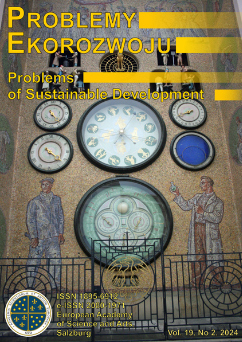Wzrost niskowęglowy: zrównoważoność i rozwój technologiczny z perspektywy Indii
Purnamita Dasgupta
Environmental and Resource Economics Unit, Institute of Economic Growth University of Delhi Enclave (North Campus), Delhi 110007 (Indie)
Nisha Taneja
Indian Council for Research on International Economic Relations, Core 6A, 4th Floor, India Habitat Centre, New Delhi 110003 (Indie)
Abstrakt
Artykuł przedstawia doświadczenia związane z transferem technologii w kontekście przeciwdziałania zmianom klimatycznym na przykładzie Indii. Transfer technologii może przynieść oczekiwane rezultaty, gdy kraje rozwijające się sprostają standardom zawartym w międzynarodowych porozumieniach. W kontekście zmian klimatycznych i transferu technologicznego została przeanalizowana skuteczność instrumentu CDM (Clean Development Mechanism, mechanizm czystego rozwoju). Uwzględniono aspekty społeczno-polityczne i ekonomiczne. Przykład wrażliwości indyjskiego eksportu w obliczu alternatywnych systemów regulacyjnych, takich, jak nałożenie podatku węglowego, ukaże znaczenie mechanizmów transferu technologii pomiędzy rozwiniętymi a rozwijającymi się krajami. Osiągnięcie rozwoju zrównoważonego przy pomocy wybiegających w przyszłość mechanizmów transferu technologicznego pozwoli powiększyć wkład Indii do globalnego rozwiązania problemu klimatycznego.
Słowa kluczowe:
zmiany klimatyczne, rozwój zrównoważony, transfer technologii, mechanizm czystego środowiska, umowy handloweBibliografia
AMRICAN Clean Energy and Security Act 2009 (Waxman-Markey Bill 2009), http://www.opencongress.org/bill/111-h2454/show.
Google Scholar
DASGUPTA, P., Economics and Climate Change: Some Relevant Aspects for Human Security in India, in: Security Challenges and Implications of Climate Change for India, IDSA, Academic Foundation, Delhi 2009.
Google Scholar
DASGUPTA, P., TANEJA, N., 2010, Trade, Technology Transfer and Climate Change, in: Economic and Political Weekly, Volume XLV No. 3, January p. 16-22.
Google Scholar
ELLIS, J., MORAIF, S., KIM J.A., Reporting And Recording Post-2012 GHG Mitigation Commitments, Actions and Support, No.COM/ ENV/EPOC/IEA/SLT(2009)4, OECD 2009.
Google Scholar
GERMAIN, M.., MAGNUS, A., VAN STEENBERGHE, V., 2007, How to design and use the clean development mechanism under the Kyoto Protocol? A developing country perspective, in: Environmental and Resource Economics, Vol. 38, Number 1, September.
Google Scholar
GOVERNMENT of India Submission to UNFCCC on Technology Transfer Mechanism, http://unfccc.int/files/kyoto_protocol/application/pdf/indiatechtransfer171008.pdf.
Google Scholar
LETTER TO UNFCCC regarding listing in the Chapeau to the Copenhagen Accord, March 8, 2010, Government of India, http://unfccc.int/files/meetings/application/pdf/indiacphaccord.pdf.
Google Scholar
MoEF, India’s GHG Emissions Profile - Results of five climate modeling studies, Ministry of Environment and Forests, Government of India, September 2009, http://www.moef.nic.in.
Google Scholar
MoEF, India’s Submission to the UNFCCC, Ministry of Environment and Forests, Government of India, August 2009, http://www.moef.nic.in/downloads/home/UNFCCC-final.pdf.
Google Scholar
NARAIN, U., VAN’T VELD, K., 2008, The Clean Development Mechanism’s Low-hanging Fruit Problem: When Might it Arise, and How Might it be Solved?, in: Environmental and Resource Economics, Vol. 40, Number 3, July.
Google Scholar
RAMESH S.J., Remarks of the Minister of State (Independent Charge) Environment and Forests, Government of India at the 6th MEF meeting, Washington D. C., April 18th, 2010. Communication from MoEF, GOI.
Google Scholar
REPORT, Report of the Conference of the Parties on its fifteenth session, held in Copenhagen from 7 to 19 December 2009, Addendum, Part Two: Action taken by the Conference of the Parties at its fifteenth session, Advance version, 30 march 2010. http://unfccc.int/resource/docs/2009/cop15/eng/11a01.pdf.
Google Scholar
SAQIB, M., SEHGAL, R., PAMLIN. D., Indian Companies in the 21st Century, WWF, Delhi 2009.
Google Scholar
SERES, S., Analysis of Technology Transfer in CDM projects, UNFCCC 2008.
Google Scholar
SUBRAMANIAN, A., BIRDSALL, N., MATTOO, A., 2009, India and Climate Change: Some International Dimensions, in: Economic and Political Weekly, Vol. 44 No. 31 August.
Google Scholar
THE Copenhagen Accord, http://unfccc.int/home/items/5262.php.
Google Scholar
UNFCCC, Clean Development Mechanism: 2008 In brief, United Nations Framework Convention on Climate Change, 2008, http://unfccc.int/resource/docs/publications/08_cdm_in_brief.pdf.
Google Scholar
UNFCCC The Marrakesh Accords and the Marrakesh Decleration, http://unfccc.int/cop7/documents/accords_draft.pdf.
Google Scholar
UNFCCC, United Nations Framework Convention on Climate Change, http://cdm.unfccc. int/Statistics/index.html.
Google Scholar
WORLD BANK, Clean Development Mechanism projects in India, The World Bank, http://search.worldbank.org/projects?qterm=clean+development+mechanism&_ctry_exact=Republic+of+India
Google Scholar
WTO-UNEP, Trade and Climate Change, World Trade Organisation and United Nations Environment Programme, Geneva 2009.
Google Scholar
Autorzy
Purnamita DasguptaEnvironmental and Resource Economics Unit, Institute of Economic Growth University of Delhi Enclave (North Campus), Delhi 110007 Indie
Autorzy
Nisha TanejaIndian Council for Research on International Economic Relations, Core 6A, 4th Floor, India Habitat Centre, New Delhi 110003 Indie
Statystyki
Abstract views: 38PDF downloads: 18
Licencja

Utwór dostępny jest na licencji Creative Commons Uznanie autorstwa – Na tych samych warunkach 4.0 Miedzynarodowe.




